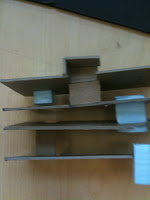
This model has pieces that penetrate the wall and form continuous spaces that act on a different axis then the walls.

Yet this second model has also of nice sectional qualities... there are 4 clear bars of "pushing and pulling" that adjust the 7 walls. I created this second model to help me understand what can happen to this wall on the three floors. How does it move? What set of conditions limit it? Will every shift mean there is other program in that area? Or is restricted to reading rooms? Do I break out of the double square space to add other program? Now along with all these things I to decide how the wall interacts with a horizontal plane to attach the walls in some areas. This is the main issue, how I mesh these to models to make a cohesive whole.


























